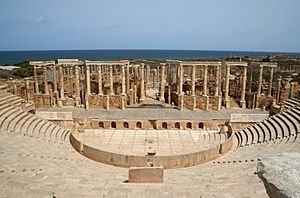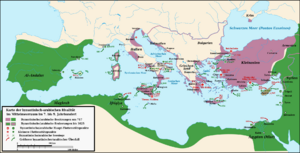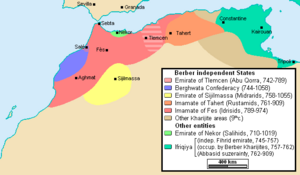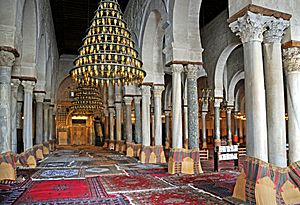Muslim conquest of the Maghreb facts for kids
Quick facts for kids Muslim conquest of the Maghreb |
|||||||||
|---|---|---|---|---|---|---|---|---|---|
| Part of the Arab Conquests and the Arab–Byzantine wars | |||||||||
 Roman Theatre at Leptis Magna |
|||||||||
|
|||||||||
| Belligerents | |||||||||
| Rashidun Caliphate Umayyad Caliphate |
Byzantine Empire Kingdom of Altava Kingdom of the Aurès Kabyle confederations Kingdom of Ouarsenis Kingdom of Hodna Various other Berber tribes and statelets |
||||||||
| Commanders and leaders | |||||||||
| Amr ibn al-As Abdallah ibn Sa'd Zubayr ibn al-Awwam Abd Allah ibn al-Zubayr Uqba ibn Nafi † Abu al-Muhajir Dinar † Musa ibn Nusayr Hassan ibn al-Nu'man Tariq ibn Ziyad Zuhayr ibn Qays † |
Gregory the Patrician † Dihya † Kusaila † John the Patrician |
||||||||
The Muslim conquest of the Maghreb was a series of military campaigns. These campaigns were led by the Rashidun Caliphate and later the Umayyad Caliphate. They took place in North Africa, a region known as the Maghreb. The conquests started in 647 AD and ended in 709 AD. During this time, the Byzantine Empire lost its last strongholds in the area. These campaigns were a big part of the quick early Muslim conquests that happened over a century.
By 642 AD, under Caliph Umar, Arab Muslim forces had taken control of many lands. These included Mesopotamia, Syria, and Egypt. They also invaded Armenia. These areas were once shared by the powerful Byzantine and Sasanian empires. The Muslims were also finishing their conquest of Persia. It was at this time that Arab armies first moved into North Africa, west of Egypt. These expeditions continued for years, helping the spread of Islam.
In 644 AD, Uthman became the new Caliph. During his 12-year rule, Armenia, Cyprus, and all of modern-day Iran were added to the growing Rashidun Caliphate. Muslim forces also targeted Afghanistan and North Africa. Muslim ships raided areas from Rhodes to the southern coasts of Spain. The Byzantine navy was defeated in the eastern Mediterranean Sea.
Contents
First Muslim Expeditions
The first Muslim expeditions into the Maghreb began around 647 AD. One story tells how Muslim soldiers captured Tripoli. Seven soldiers found an unwalled part of the city's beach. They snuck in and caused a commotion. This made the Byzantine guards think the Muslim army was already inside. The guards fled, and the city was easily taken.
Later, Muslim forces tried to capture Barqa (Cyrenaica) for about three years. They could not break through. Then, Khalid ibn al-Walid suggested a new plan. They used a catapult filled with cotton sacks. At night, warriors like Zubayr ibn al-Awwam were launched over the city wall. They opened the gates, allowing the Muslim army to enter and capture the city.
However, Caliph Umar did not want to send more troops into North Africa. Muslim rule in Egypt was still new. He ordered his general, 'Amr, to focus on Egypt. So, 'Amr left Tripoli and Barqa and returned to Egypt in 643 AD.
Battle of Sufetula
The next invasion of the Maghreb happened in 647 AD. It was ordered by Abdallah ibn Sa'd. An army of 20,000 soldiers marched from Medina. More soldiers joined them in Egypt. Abdallah ibn Sa'd then led them into Byzantine Africa. They took control of Tripolitania, which is in modern-day Libya.
Count Gregory, the local Byzantine governor, had declared himself independent. He gathered his allies to fight the Arab forces. In 647 AD, they met at the Battle of Sufetula. This city was about 240 kilometers (150 miles) south of Carthage. Gregory's forces were defeated, and he was killed.
After Gregory's death, his successor agreed to pay tribute to the Arabs. This led to the Arab army withdrawing. The campaign lasted 15 months, and Abdallah's forces returned to Muslim lands in 648 AD.
Changes in Leadership
Further Muslim conquests were stopped for a while. Caliph Uthman was murdered in 656 AD. He was replaced by Ali, who was also assassinated in 661 AD.
Then, the Umayyad Caliphate was formed in Damascus. Caliph Muawiyah I began to strengthen the empire. He appointed a governor in Egypt. He then continued to invade neighboring non-Muslim states. He attacked Sicily and Anatolia in 663 AD. In 664 AD, Kabul, Afghanistan, fell to the Muslim armies.
Second Wave of Invasions
From 665 to 689 AD, a new Arab invasion of North Africa began. This was done to protect Egypt from attacks by the Byzantines. An army of over 40,000 Muslims marched through the desert to Barca. They captured it and moved towards Carthage. They defeated a Byzantine army of 20,000 soldiers.
Next, a force of 10,000 Muslims arrived. They were led by the general Uqba ibn Nafi. Thousands more joined them. This army marched into Africa. In 670 AD, the city of Kairouan was founded. It became a safe place and a base for future operations. Kairouan became the capital of the Islamic province of Ifriqiya. This area is now western Libya, Tunisia, and eastern Algeria.
Uqba's Journey to the Atlantic
Uqba ibn Nafi was a very brave general. He traveled deep into the country. He went through the wilderness where later cities like Fes and Morocco were built. He finally reached the edge of the Atlantic Ocean and the great desert. He conquered many areas in the Maghreb. He attacked coastal cities like Bugia and Tangier. These areas were once part of the Roman province of Mauretania Tingitana.
However, Uqba was eventually stopped. He could not capture Tangier. He was forced to turn back towards the Atlas Mountains by a man known as Count Julian.
Berber and Byzantine Resistance
Uqba could not hold onto his new conquests for long. There was a widespread rebellion against Muslim rule by the Greeks and Africans. This forced him to return from the Atlantic coast. On his way back, a group of Berbers and Byzantines attacked his forces. This coalition was led by the Berber king Kusaila. They ambushed Uqba's army near Biskra. Uqba was killed, and his troops were wiped out.
Another general, Zuhayr ibn Qays, tried to avenge Uqba. He won many battles against the local people. But he was defeated by a strong army sent by Constantinople to help Carthage.
Meanwhile, a new civil war broke out among rivals for power in Arabia and Syria. This conflict lasted until 692 AD.
Third Wave of Invasions
After the civil war ended, the Caliphate could focus again on conquering North Africa. The invasion of Ifriqiya began again. The general Hassan ibn al-Nu'man was given command. He had an army of 40,000 men.
The inland areas had been won and lost many times. But the coast was still controlled by the Greeks (Byzantines). Hassan's predecessors had respected the strong walls of Carthage. But Hassan was bolder. He attacked and looted Carthage in 695 AD. It seems he used scaling ladders for a quick assault.
Fall of Carthage
After losing Carthage, the Byzantine Empire sent troops from Constantinople. Soldiers and ships from Sicily and Spain also joined them. This forced the Arab army to retreat to Kairouan. The Christians landed, and the people of Carthage welcomed them.
In 698 AD, the Arabs, led by Hassan ibn al-Nu'man, finally conquered Carthage. They completed the conquest of the eastern Barbary coast. To prevent the Byzantines from taking it back, they decided to destroy Carthage. Its walls were torn down, and the farmlands were ruined. The water systems and harbors were made unusable. Instead, they built up Tunis as their new base. Kairouan remained the governor's capital for a while.
Berber Uprising
Right after this, the Berbers rebelled against their new Arab rulers. They won a big victory at the Battle of Meskiana. Their queen, Kahina, led the independent tribes. She was seen as a prophetess, and her followers fought with great passion. Hassan's experienced army was not strong enough. The conquests of an entire age were lost in a single day. The Arab leader retreated to the borders of Egypt.
In 703 AD, five years later, Hassan received new troops from the caliph. By this time, the people in North African cities were tired of the Berber rule. So, Hassan was welcomed back. He managed to kill Kahina at the Battle of Tabarka.
The successful general Musa bin Nusair was made governor of Ifriqiya. His armies harshly put down the Berbers who fought against the advancing Muslims. These Berbers belonged to various faiths. Musa's conquest reached the Atlantic coast in 708 AD. He was known for having many mawla, which were Berber converts to Islam and people from other regions.
Musa also had to deal with the Byzantine navy. So, he built his own navy. This navy went on to conquer the Christian islands of Ibiza, Majorca, and Menorca. As his forces moved into the Maghreb, they took Algiers in 700 AD.
After the Conquest
By 709 AD, almost all of North Africa was under the control of the Arab caliphate. The only possible exception was Ceuta, a fortress at the African Pillar of Hercules. Some sources say Ceuta was the last Byzantine outpost in Africa. Its leader, Julian, might have been a Byzantine governor or a Berber lord. Julian was a skilled diplomat. He might have surrendered to Musa under terms that allowed him to keep his title. Ceuta had many refugees from a civil war in Spain. These included Christians and Jews.
Julian offered his help to Musa against the Visigothic king in Spain. Musa saw that Julian held the "keys to the Spanish monarchy." So, Musa ordered some initial raids on the southern coast of Spain in 710 AD. In the spring of that year, Tariq ibn Ziyad—a Berber general—took Tangier. Musa made him governor there.
The next year, 711 AD, Musa told Tariq to invade Spain. Tariq sailed from Ceuta using ships provided by Julian. He went into Spain, defeated the king, and attacked the capital city of Toledo. He and his allies also captured other cities like Córdoba and Seville. This Umayyad conquest of Hispania completed the Arab conquest of North Africa.
The destruction of Carthage marked the end of the Byzantine Empire's influence in the region. However, archaeological evidence shows that Carthage continued to be lived in. Its ruins were used as building materials for Kairouan and Tunis.
Local Resistance
Even though the area was under Arab control, some people still resisted. The Berber people were sometimes treated unfairly. They were made to convert to Islam and join the Arab army. They often received less pay than Arab soldiers. This caused a lot of unhappiness. It even led to the death of a Maghreb Arab governor, Yazid ibn Abi Muslim. He was killed by one of his bodyguards.
In 740 AD, a Berber Revolt started because of taxes on the Berbers. The rebels were led by Maysara. It began in southern Morocco and lasted until 743 AD. The rebels killed many Arabs in Tangier and captured territory. This included modern Morocco and parts of Algeria. These areas were never fully recovered by the eastern Caliphate. However, they failed to capture Ifriqiya (Tunisia and parts of Algeria and Libya).
One thing that helped unite these rebellions was the teachings of Arab Kharijite missionaries. They were merchants who converted some people to their way of thinking. This gave the Berber rebellion of 739-743 AD a strong sense of purpose.
Impact of the Conquest
Changes in the Mediterranean
Losing Africa was a big blow to the Byzantine Empire. In 698 AD, they lost their second large granary and a major source of taxes. This weakened the empire's ability to defend itself against the Caliphate. The financial loss was huge and hard to recover from.
The fall of Carthage also led to a change in Byzantine emperors. This conquest meant there were no longer any major Latin-speaking provinces in the Byzantine Empire. Greek became the main language.
With Carthage captured, the Arabs gained control of the western Mediterranean Sea. They could use the African ports to launch attacks on islands like the Balearic Islands, Sardinia, and Sicily. They also prepared for the invasion of Spain 13 years later.
Islam and Arab Culture in the Maghreb
After the conquest, the Latin and Punic-speaking people of Carthage gradually became Arabized. The Latin language did not disappear right away. Latin words can still be found in today's Berber languages. The dialects of Maghrebi Arabic also show Latin influences. Christianity also continued to exist for some time.
In Tunisia, most people were Muslim by the end of the ninth century. Christian communities slowly declined. Some individual communities survived until the 14th century. By the time the French arrived in the Maghreb, there were no longer any Latin-speaking or Christian communities. This complete Islamization divided the Mediterranean region into northern and southern halves, which continues today.
Several things may have helped Islam and Arab culture spread in the Maghreb:
- Some people already spoke a Semitic language, similar to Arabic.
- Some Christian groups had ideas that were similar to parts of Islam.
- The Christian Church in Africa was divided.
- The location of the Maghreb, facing Spain, encouraged Arabization and Islamization.
Christianity After the Conquest
Research shows that Christianity continued to exist after the Muslim conquests. The Catholic Church slowly declined along with the local Latin language. Some believe that Christianity continued for about a century after the conquest. The Church could not stop the spread of Islam. This was partly because they were already divided. The Muslim rulers were generally tolerant of Christians, treating them as "People of the Book." Some historians think that if the Muslims had persecuted Christians, Christianity might have survived better.
Many reasons led to the decline of Christianity in the Maghreb. These include constant warfare and some persecutions. Many Christians also moved to Europe. The Church at that time lacked strong monastic traditions. It was also still recovering from earlier disagreements. This may have led to its disappearance in the Maghreb. In contrast, Egypt had a strong monastic tradition. This helped the Coptic Church remain the main faith there for a long time.
Local Catholicism faced pressure when stricter Muslim rulers, like the Almoravids and Almohads, came to power. There were reports of persecutions. Christians in Tunis were asked to convert to Islam. Reports from around 1150 AD still mention Christian residents and a bishop in Kairouan. This city was founded by Arab Muslims around 680 AD. A letter from the 14th century shows that only four bishoprics were left in North Africa. This was a sharp drop from over four hundred at the time of the Arab conquest.
The Almohad ruler Abd al-Mu'min forced Christians and Jews in Tunis to convert in 1159 AD. Some historians mention a native Christian community in the 14th century. These Berber Christians continued to live in Tunis until the early 15th century.
Another group of Christians, called the Mozarabs, came to North Africa. They were deported from Islamic Spain. They were recognized as forming the Moroccan Church by Pope Innocent IV.
A new phase of Christianity in Africa began when the Portuguese arrived in the 15th century. After the Reconquista in Spain, Christian Portuguese and Spanish forces captured many ports in North Africa.
In 1225, Pope Honorius III allowed two friars to start a mission in Morocco. They were to look after Christians there. The Bishop of Morocco was made the head of the Church of Africa in 1246. Pope Innocent IV asked the rulers of Tunis and other cities to let the friars care for Christians. He thanked the Caliph for protecting Christians.
The bishopric of Marrakesh continued until the late 16th century. Franciscan monasteries existed in the city until the 18th century.
Images for kids
-
The Arab general Uqba Ibn Nafi founded the Great Mosque of Kairouan in Kairouan, Tunisia, 670 AD.
See Also
- Arab conquest of Egypt
- Arab-Berber
- Arabized Berber
- Arab–Byzantine wars
- Barbary Coast
- Berber Jews
- Berber Revolt
- Berbers and Islam
- History of Algeria
- History of Islam in southern Italy
- History of Tunisia
- Kabylism, Algerianism, Berberism
- Moors
- Rougga Treasure






